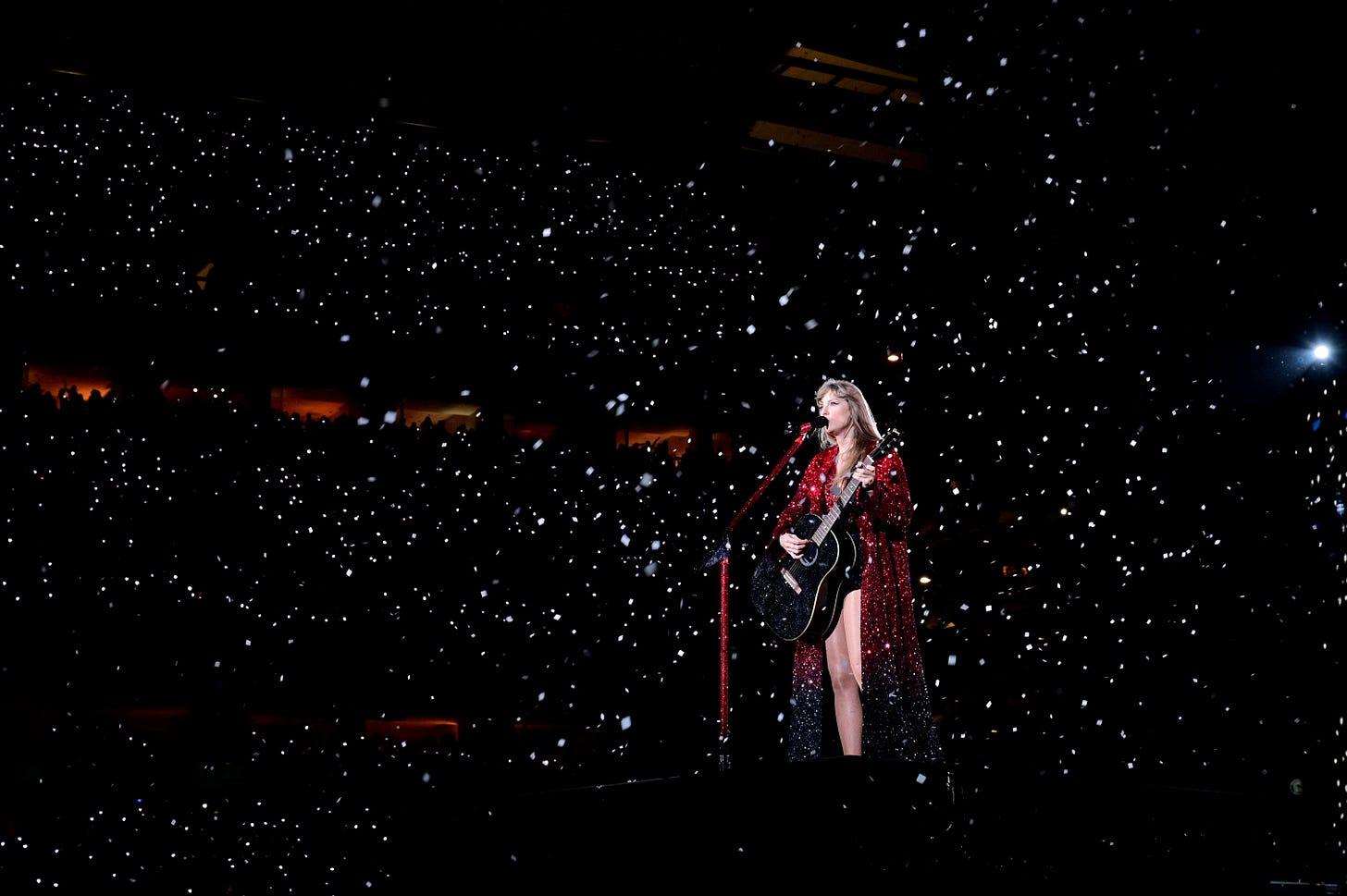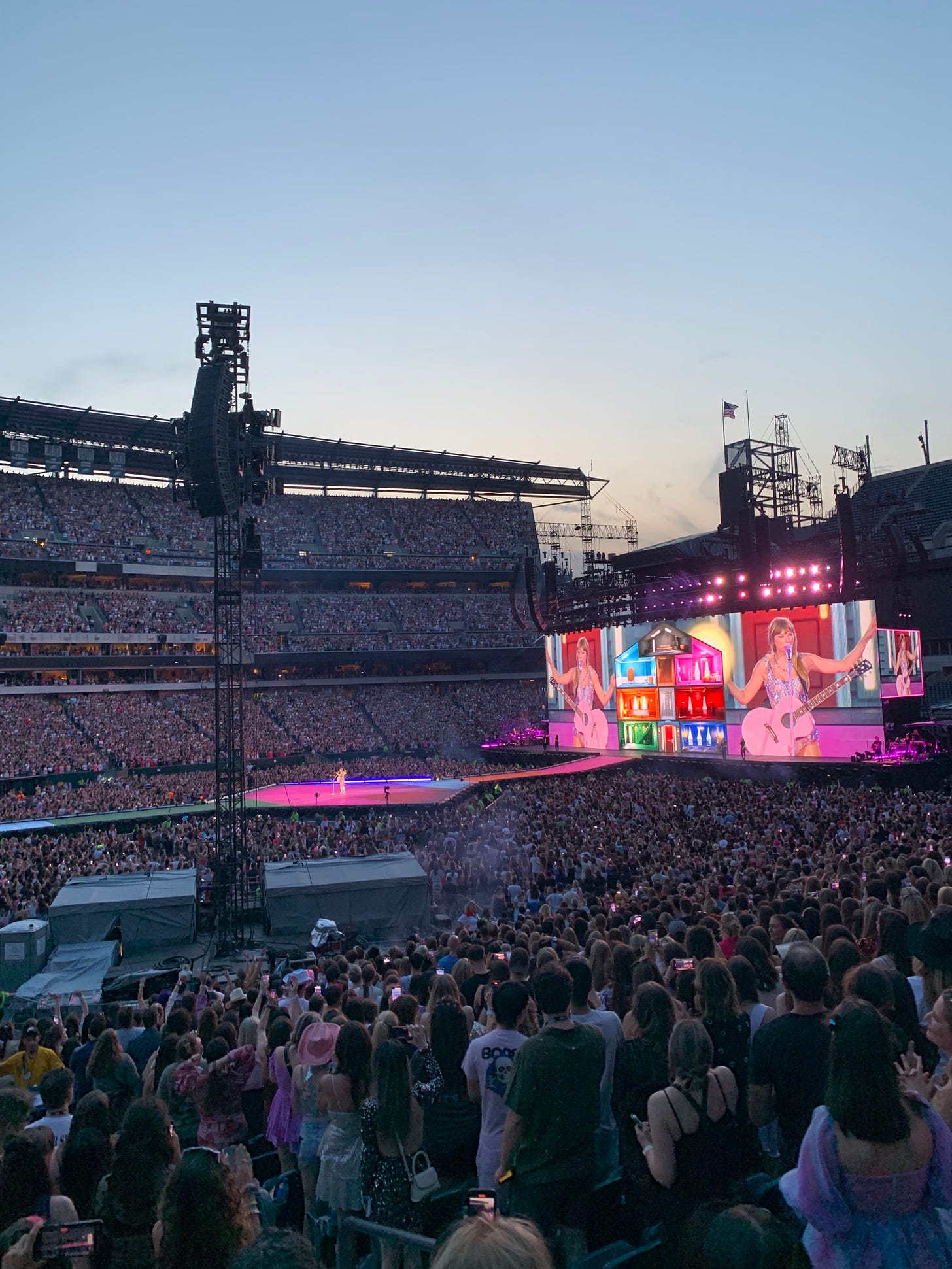The Greatest Show on Earth
Taylor Swift’s electrifying Eras Tour brings people together like nothing else—and reveals our need for basic human connection

“If there's a blueprint for a future utopia in the year 2023,” Minneapolis Star Tribune music critic Chris Riemenschneider confidently declared in the wake of the second Twin Cities show of Taylor Swift’s ongoing Eras Tour, “it could come from a Swift concert.”
After witnessing two of those concerts myself—once in Philadelphia and then in Minneapolis—I believe it.
Music—and live music in particular—brings people from different backgrounds and walks of life together like little else. We’ve all seen footage of Beatlemania and Woodstock and Queen at Live Aid, for instance, and virtually all of us can recall memorable moments from live shows we’ve attended. I’ve seen it myself many times before, whether at Swift’s own previous stadium show in 2018 or an untold number of arena spectacles put on by Bruce Springsteen, Prince, and the Rolling Stones. It’s a spirit that’s just as present at amphitheater and smaller venue performances from acts like Foo Fighters, Gary Clark, Jr., and Robert Plant and Alison Krauss, as well as comparatively staid locales like jazz or blues clubs and symphony or opera halls.
Even so, I wasn’t prepared to experience Swift’s current tour. Nothing I’ve seen in all my years of concert-going compares to this extravaganza; it’s a surreal, otherworldly experience, one that needs to be seen and felt first-hand to be believed.
If all that sounds weird or abnormal, well, it is—but in a very good way. These shows are a living, breathing testament to the power of music to bring people together, a three-and-a-half-hour celebration of life and the sort of shared, uplifting experience that’s all too rare in contemporary American society.
Swift stands at the heart of it all and binds everything together, the magnetism of her stage presence rising to meet her skills as a songwriter. Her performance weaves spectacle and storytelling together into a cohesive whole that’s more than the sum of its parts, transforming immense stadiums into intimate venues with seemingly little effort. She takes even the most introspective and pensive songs from recent albums like folklore and evermore and scales them up into majestic productions fit for such a large stage—all without losing their confessional, soul-searching essence.
That doesn’t detract from the literal pyrotechnics that accompany much of the rest of the show. Sparks shower down at the beginning of one set and flames flash up during the performance of “Bad Blood,” a hit from her smash album 1989, while fireworks and confetti bring the evening to a close. Impressive sets and staging likewise allow the assembled faithful to catch at least one decent glimpse of Swift over the course of the night, whether from a raised platform on the stage itself or on the colossal video display always behind her.
But Swift herself remains the most exhilarating part of the show. She commands the attention and laser-like focus of tens of thousands of people, all amidst the technicolor chaos or vast darkness that surrounds her. What’s more, she displays incredible stamina, dancing and running up and down a football-field length stage, climbing up and down sets and scaffolding, for well over three hours—more often than not in glittering heels—all without missing a note or a mark. It’s impossible not to admire her determination to put on the most spectacular show possible or her dedication to her craft as a performer.

Long live all the magic we made…
As much as Swift’s concerts illustrate the power of music to bring people together, they also reflect the intimate emotional connection she’s cultivated through her intensely personal yet universal songwriting. Her music means something special to Swift and her legions of fans, something that draws us all together and makes our brief time together transcendent. It’s an experience that satisfies our basic human craving for camaraderie and community, if only for one night.
But not just one night—Swift and her tour don’t just lurch toward your favorite city; they take it by storm. She effectively seized control of both Philadelphia and Minneapolis the weekends she was in town, steamrolling into each city as hordes of fans clog up public transit and swamp downtown areas. Tourism in Philadelphia, for instance, nearly reached pre-pandemic levels during Swift’s weekend shows mid-May, while the estimated economic impact of her pair of late June concerts in Minneapolis rivaled pre-pandemic sporting events like Super Bowl LII in 2018 and the Final Four in 2019.
Indeed, it was hard to make my way around Philadelphia without encountering fellow Swifties, while it proved easy to strike up conversations about the show at craft breweries and shops in and around the Twin Cities. Throngs of fans gathered in the baking midday sun and humid afternoons to queue up in absurdly long lines for merch hours before the show itself, then mingled and sweated together as we waited for the stadium doors to finally open a couple hours before the concert’s posted start time. It’s the sort of communal experience and sense of belonging that people have traditionally sought in religion and more recently, to our collective detriment, in politics.
As might be expected, the audience was heavily female—many decked out in sparkly, sequined outfits related thematically to their favorite albums and songs and music videos or Swift’s own innumerable concert outfits over the years. Devotees of records like Red and Lover and reputation were perhaps most prominent, but virtually every era and facet of Swift’s now-long career could be found among the assembled congregation. It’s an impressive level of commitment, one that helped create the celebratory atmosphere that pervaded the stadium even before the gates opened. More to the point, though, these outfits give a sense of what Swift’s music means to those of us in attendance; it’s cosplay on a scale I’ve only seen once before, at the midnight premiere of The Avengers back in 2012.
Swift finally took the stage just before eight o’clock on both evenings. In Philadelphia, I could feel the concrete shake as Swift and her band went through the Fearless set—an experience I’ve only had at an AC/DC concert—and I could barely hear Swift herself over tens of thousands of screaming fans belting out the lyrics to favorites like “You Belong With Me” and “Love Story” at the top of their lungs. Back in Minneapolis, time and again some 60,000 voices overwhelmed nearby stacks of speakers and echoed across the cavernous indoor expanse of U.S. Bank Stadium. Swift herself obviously revels in and draws energy off her crowds, constantly expressing gratitude and on occasion taking out her in-ear monitors to receive the full experience.
For just over three hours, we all stop caring about anything other than the moment we were all sharing; we’re totally absorbed in and enthralled by the here and now. Even though we’re all exhausted by show’s end, we’re still fully engaged and more than willing to keep on going for another three hours.

This night is flawless, don’t you let it go…
And with good reason: Swift’s concerts meet our needs for human connection and desire for intimacy. It’s as if the assembled concert crowd and her performance incarnate the themes she’s explored and expressed in her music, as well as the very power of music itself to bring people together. I’d be shocked if I encounter the couples I stood next to and chatted with in Philadelphia or the two teenage girls in Minneapolis who ransacked their friendship bracelet collection to find one that would fit my wrist ever again—but for two separate nights in May and June, we had something simple but nonetheless vital in common.
Lingering fallout from the COVID-19 pandemic almost certainly has something to do with the intensity of the response to Swift’s current tour; Swift herself noted that the pandemic made it difficult to satisfy her own need to connect with her fans (though that thwarted desire produced her two best albums, folklore and evermore). Swifties or not, though, most of us likely have a pent-up desire for shared experiences that’s gone unfulfilled for so long—whether that involves an ear-splitting heavy metal concert or a quiet stroll through a museum. Put simply, we all want to live our lives after a period of severe disruption and isolation. The intimate nature of Swift’s music and the sincere, deep-seated connection she’s forged with her fans over the years only amplify this baseline yearning, yielding the euphoric collective and individual responses to her tour that I experienced up close.
There may be nothing else quite like Taylor Swift’s Eras Tour in this day and age, but other musical acts and events—like, say, an Opening Day baseball game or a live rendition of Gustav Holst’s The Planets—meet the same underlying need for connection in equally healthy ways. At bottom, they’re all deeply human experiences that elevate as much as they delight and entertain us, ones we need if we’re to break out of the current national funk that’s seen so many on both left and right substitute politics for religion and philosophy, personal meaning, and basic connection with their fellow human beings.
But the uncomplicated, joyous fellowship I saw and felt at Taylor Swift’s concerts in Philadelphia and Minneapolis gave me hope—a sense of optimism that we’ll be able to fulfill our basic need for human connection and belonging in ways much more meaningful and ultimately beneficial to ourselves and others than mere politics.
Maybe, just maybe, we can finally glimpse daylight from here.




